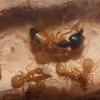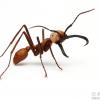So I noticed that my Camponotus sanctus ant colony has been producing pupae with cocoons since the first nanitics but my Messor wasmanni colony pupae have all been naked and still is, is there a reason for that ? or just because they are different species ?
Edited by CozmoDog, June 28 2016 - 8:23 AM.















